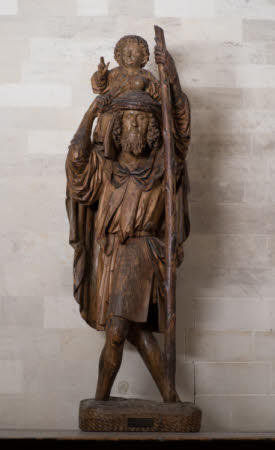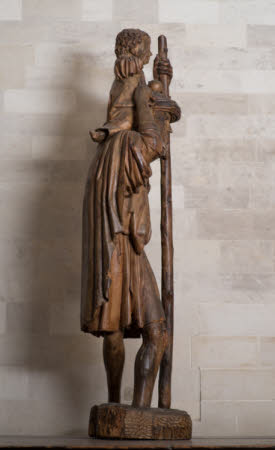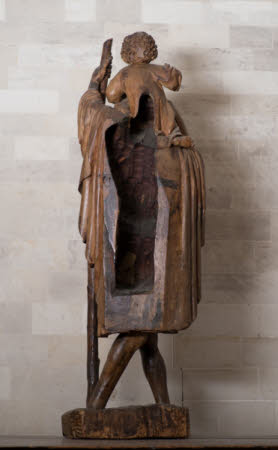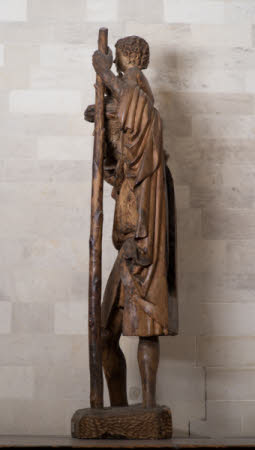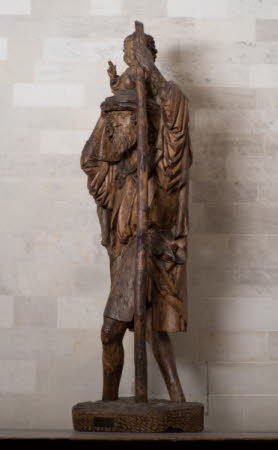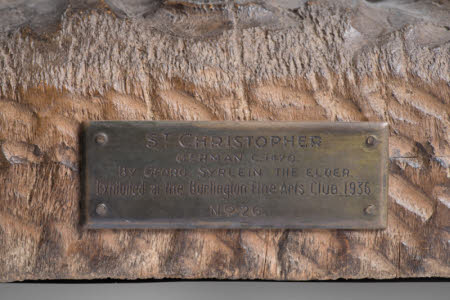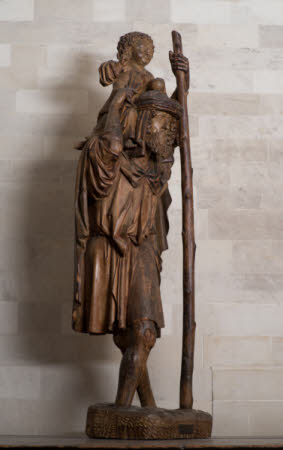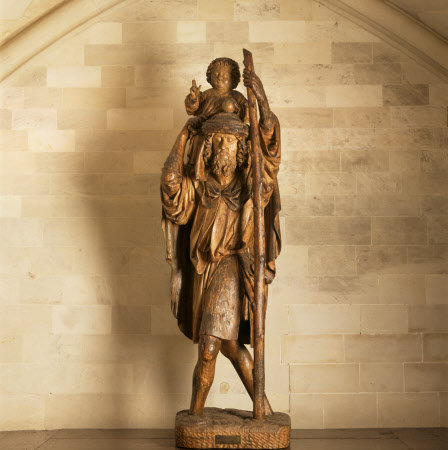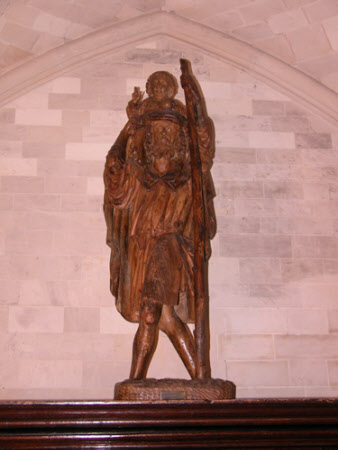Saint Christopher
circle of Michel Erhart (1440/45 - Ulm 1522/23)
Category
Art / Sculpture
Date
circa 1470
Materials
Limewood, paint
Measurements
1180 x 380 x 273 mm
Place of origin
Ulm
Order this imageCollection
Anglesey Abbey, Cambridgeshire
NT 514381
Summary
Limewood, Saint Christopher, circle of Michel Erhart (c. 1440/45 – c. 1522/23), Ulm, Southern Germany, c. 1470. A carved and painted limewood sculpture of the former Saint Christopher wading through water, his staff in his left hand, the Christ Child seated upon his shoulders, his right hand raised in blessing. Christopher holds fast to Christ’s robe with his right hand. The sculpture was made in Ulm in Southern Germany, probably around 1470, by a sculptor in the circle of Michel Erhart. Formerly attributed to Jörg Syrlin the elder (c.1425 -c.1491). A metal label inscribed 'St Christopher by Georg Syrlein the elder of Ulm c.1470.'
Full description
Saint Christopher is no longer recognised as a saint by the Catholic church, nevertheless he continues to be worshipped, with Christopher talismans remaining popular to this day with drivers and other travellers. The story of Christopher’s carrying Christ across the river is recounted in the Golden Legend, a collection of saints’ tales, many of them invented, by the Italian churchman Jacopo de Voragine (c. 1230-98), which became immensely popular in the Medieval and early modern periods. The giant Christopher decided to serve Christ by guiding the poor and weak across a river. One night he carried a small child who, as they crossed grew ever heavier. Eventually Christ revealed his identity, explaining to Christopher that he had been carrying the weight of the world upon his shoulders. Christ also instructed Christopher to plant in the ground his staff, made from a palm tree. After Christopher had done this, the staff flowered and bore fruit. Christopher was one of the Fourteen Holy Helpers, a group of saints, intercession with whom was regarded as especially effective for protection against diseases and other misfortunes. The huge popularity of Saint Christopher in the Middle Ages arose from the belief that whoever looked at the image of the saint would, for that day at least, enjoy protection from the risk of accidents or a sudden death without the opportunity to receive the all-important Last Sacraments. This sculpture is an excellent example of the school of limewood carved sculpture that had its centre in southern Germany, notably in the city of Ulm, during the period c. 1450-1525 (for a survey, see Michael Baxandall, The Limewood Sculptors of Renaissance Germany, New Haven/London 1980). The effective founder of the school of limewood figurative carving in Ulm was the Swabian sculptor Hans Multscher (c. 1400-67), whose naturalistic style, as seen for example in the figures carved for Multscher’s altarpiece in Sterzing (Vitipeno) in South Tirol, determined the development of limewood sculpture in the city (Ulrich Södling, Hans Multscher. Der Sterzinger Altar, Bozen 1991). The Anglesey Abbey Saint Christopher is a powerful narrative sculpture in its telling of the story of the giant Christopher taking onto his shoulders the unknown child; it is intensely naturalistic, in the modelling of the draperies and in details such as Christopher’s belt and - a delightful touch – Christopher’s grasping a handful of Christ’s tunic with his right hand, to ensure his passenger stays firmly on his shoulders. Overall, the quality of the carving is very fine; this, and the magnificent conception, suggest the hand of a master sculptor. The sculpture was first recorded in 1936, when it was lent by Lord Fairhaven to the Burlington Fine Arts Club Gothic Art in Europe exhibition. In the exhibition, the sculpture was attributed to the Ulm sculptor Jörg Syrlin the Elder (died 1491). Syrlin and his son Jörg the Younger (died c. 1521) were joiners in Ulm, who obtained commissions for wooden complexes that often included much sculpture, for example the choirstalls in the Cathedral in Ulm, for which Jörg the Elder contracted in 1469. The stalls contain a series of impressive carved half-length figures of sybils and ancient philosophers (Julius Baum, Die Ulmer Plastik um 1500, Stuttgart 1911, pp. 21-31, Tafeln 6-9, 15; Wolfgang Deutsch, ‘Der ehemalige Hochaltar und das Chorgestühl, zur Syrlin- und zur Bildhauerfrage’ in eds. Hans Eugen Specker and Reinhard Wortmann, 600 Jahre Ulmer Münster. Festschrift, Ulm 1977, pp. 242-322; Albrecht Miller, ‚Das Ulmer Chorgestühl und Michel Erhart‘ in eds. Stefan Roller and Michael Roth, Michel Erhart & Jörg Syrlin d. Ä., exh. cat., Ulmer Museum, Ulm 2002, pp. 44-53). Whilst Jörg Syrlin the Ellder and his son were both long thought to be major figurative sculptors in their own right, it has become apparent that their roles are in fact likely to have been limited to design and simple joinery work, as for example in a signed lectern, dated 1458, in the Ulmer Museum (Michel Erhart & Jörg Syrlin d. Ä., no. 1). The Syrlins in fact employed a number of sculptors for the figurative elements of their works, the most important of whom was Michel Erhart (c. 1440/45 – c. 1522/23), who probably carved the busts of sybils and philosophers on the Ulm Cathedral choirstalls. The Saint Christopher shows the influence of Hans Multscher’s naturalistic style. The intense and expressive face of Christopher may, for example, be compared to Multscher’s figures of Christ as the Man of Sorrows, such as the famous figure of 1429 on the façade of Ulm Cathedral (Michel Erhart & Jörg Syrlin d. Ä., p. 89, fig. 67), or another version from the Sterzing Altar (Innsbruck, Tiroler Landesmuseum Ferdinandeum; Södling 1991, figs. 33-34). However the Anglesey Abbey Saint Christopher is likely to date from the years just after Hans Multscher’s death in 1467. The carving of the face of Christopher is close in style to the faces of some of the philosophers on the Ulm Cathedral choirstalls, for example that of Pythagoras (Michel Erhart & Jörg Syrlin d. Ä., p. 49, fig. 30). These bust-length figures carved in oak seem clearly to be products of Michel Erhart’s workshop, but are evidently the work of more than one hand and, overall, do not match the quality of Erhart’s best work in the softer and more easily carved material of limewood (Albrecht Miller, ‘Das Ulmer Chorgestühl und Michel Erhart’ in Michel Erhart & Jörg Syrlin d. Ä., pp. 44-53). The carver of the Anglesey Abbey Saint Christopher must certainly have belonged to Michel Erhart’s close circle in Ulm and may even have been a member of his workshop. Certain weaknesses in the carving, for example the mouth of Christopher, would though seem to exclude an attribution to Michel Erhart himself. A better-known figure of Saint Christopher made in Ulm is the statue in sandstone now in the Ulmer Museum, but recorded from 1584 as standing atop a column in the middle of a fountain on a square in the city, the Weinhof. It is thought to have been made around 1480/90 (Ulmer Museum, Inv. 1913.3004. Michel Erhart & Jörg Syrlin d. Ä., pp. 292-94, no. 33). Nearly twice the height of the Anglesey Abbey figure, the Ulm Saint Christopher is a dynamic sculpture, with the saint twisting his body as he turns in surprise, as Christ grabs hold of his hair to steady himself. Jeremy Warren November 2021
Provenance
Acquired by Huttleston Rogers Broughton, 1st Lord Fairhaven (1896-1966) by 1936; listed in the Anglesey Abbey inventory of 1940, p.2, Dining Hall, ‘An old carved wood figure – The Good Shepherd’ [sic], valued at £30; bequeathed by Lord Fairhaven to the National Trust in 1966 with the house and the rest of the contents.
Credit line
Anglesey Abbey, The Fairhaven Collection (The National Trust)
Marks and inscriptions
Front of base, engraved brass label: ST. CHRISTOPHER/GERMAN, c. 1480/BY GEORG SYRLEIN THE ELDER/Exhibited at the Burlington Fine Arts Club, 1936/No. 26
Makers and roles
circle of Michel Erhart (1440/45 - Ulm 1522/23), sculptor previously catalogued as attributed to Jörg Syrlin the elder (c.1425 -c.1491) , sculptor
References
'Anglesey Abbey, Lode, Cambridgeshire. An Inventory and Valuation of Furniture, Books, Ornamental Items & Household Effects .. prepared for Insurance Purposes’, Turner, Lord and Ransom, April 1940, p. 2. Christie, Manson & Woods 1971: The National Trust, Anglesey Abbey, Cambridge. Inventory: Furniture, Textiles, Porcelain, Bronzes, Sculpture and Garden Ornaments’, 1971, p. 146. Burlington Fine Arts Club. Catalogue of an exhibition of Gothic art in Europe (c. 1200-c. 1500). 1936., p. 23, no. 26. Hussey 1954: Christopher Hussey, ‘A Fenlandscape Garden – II: Anglesey Abbey, Cambridgeshire, the Home of Lord Fairhaven’, Country Life, 25 March 1954, pp. 860-63., pp. 860-63, p. 863, fig. 11.
